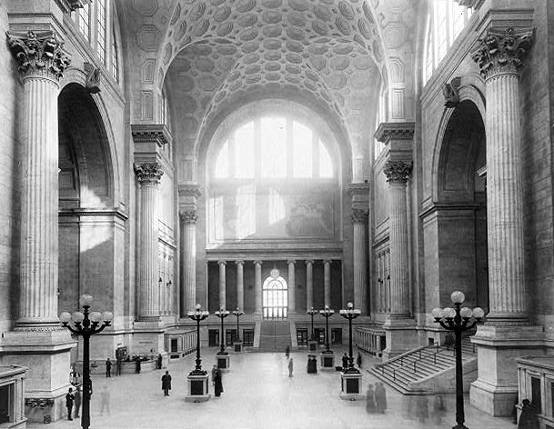Words on the Street

“Words on the Street” highlights the best New Urbs content we’ve encountered this week:
Penn Station, Reborn? | Catesby Leigh, City Journal
A decision to rebuild McKim’s station makes excellent sense on its own terms, but it also would provide the visionary, symbolic impetus that Gateway needs. Like Dresden’s glorious Frauenkirche, the faithful reconstruction of which was completed 60 years after the building’s destruction by Allied bombs, the old Penn Station was not architecture “of its time” but architecture for all time.
How Pittsburgh Can Take the Next Step | Dan Simpson, Pittsburgh Post-Gazette
If one really wanted to bring this whole area to life in terms of transportation, instead of trying to keep Pittsburgh airport alive in the face of the whims of America’s fickle airline industry, thought should be given to building a new airport, midway between Cleveland and Pittsburgh, accessed by very-high-speed rail from both cities, with future options to link the new facility with Akron, Canton, Erie, Toledo and Youngstown, also by high-speed rail. Does anyone actually believe that the old Rust Belt cities benefit from parochialism? Where is the long-term regional planning? It certainly isn’t in Harrisburg or Columbus.
Why the High Cost of Big-City Living Is Bad for Everyone | Mark Gimein, New Yorker
New York, San Francisco, Washington, Miami: these have become international centers of commerce, issuing an ever louder siren call to the global élite. … The price of the creation of these imperial cities is that they actually provide decreasing opportunities for many of those who already live in them, or for those who move to them and are not already armed with resources, status, and education. Everyone living in New York or San Francisco understands the general contours of this. Artists get pushed out of the center, the middle class gets pushed into the suburbs, and bus riders are asked to make way (literally) for tech workers.
Vladimir Putin’s Walkable Streets | Maria Antonova, Foreign Policy
Almost all of central Moscow has spent the summer enveloped in green construction gauze as workers in orange jackets labor around the clock, digging trenches along historic avenues and sawing granite chunks, sending up clouds of dust. … Moscow architect Eugene Asse said the project to make the city walkable has been well-intentioned but poorly executed. “The city must be freed of cars in its historic center and create more democratic spaces for pedestrians,” he said. At the same time, the street revamp is a “rather monstrous operation with no anesthesia,” he added. “These projects were not discussed with anyone.”
How Big Can China’s Cities Get? | Adam Minter, Bloomberg View
“Adding more density to the cities won’t work anymore,” says Alain Bertaud, a senior research scholar at New York University who has consulted in China for decades. The problem, he says, is that those cities are increasingly fragmented. Housing in Shanghai and Beijing has become so expensive that non-wealthy residents have been pushed to the furthest reaches of the suburbs, where commuters often face extended waits just to enter a subway station — let alone actually get on a train. The result is a large labor force that can’t be put to work by employers, largely defeating the purpose of urbanization.
Comments